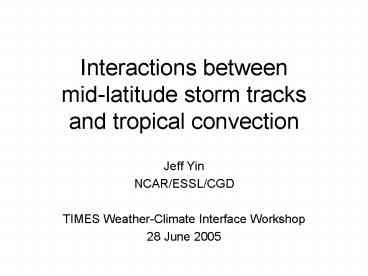Interactions between midlatitude storm tracks and tropical convection
1 / 18
Title:
Interactions between midlatitude storm tracks and tropical convection
Description:
Future work: Storm tracks connect climate variability & extreme events. Storm Tracks in Weather & Climate ... variability (ENSO, NAO, etc.) and extreme weather ... –
Number of Views:37
Avg rating:3.0/5.0
Title: Interactions between midlatitude storm tracks and tropical convection
1
Interactions between mid-latitude storm tracks
and tropical convection
- Jeff Yin
- NCAR/ESSL/CGD
- TIMES Weather-Climate Interface Workshop
- 28 June 2005
2
Outline
- Role of storm tracks in weather climate
- Links between tropical convection storm tracks
- Example from climate change
- Summary
- Future work Storm tracks connect climate
variability extreme events
3
Storm Tracks in Weather Climate
- Defined as regions of large baroclinic wave
activity, identified as maxima in bandpass eddy
statistics, such as EKE - Baroclinic waves produce precipitation and severe
weather in mid-latitudes - Transport heat moisture play large role in
global energy water cycles - Important for both weather and climate
4
Tropical Convection Storm Tracks
- Tropical convection storm tracks are linked to
tropical mid-latitude weather - However, they interact on climate time scales
(months and longer) - Examples
- ENSO drives changes in Pacific winter storm track
(California vs. Pacific NW) - Seamless poleward energy transport between Hadley
cell and storm tracks
5
Energy Transport Divergence
Data from Trenberth and Stepaniak (2003)
6
Example from Climate Change
- IPCC AR4 experiments using SRES A1b scenario 720
ppm CO2 by 2100 - 21st Century climate change Compare years
2081-2100 from SRES A1b with years 1981-2000 from
20th Century Expt - Multi-model ensembles 15 different coupled GCMs,
one member each
7
Zonal Mean Storm Tracks
2-8 day Eddy Kinetic Energy
- Storm tracks shift poleward and upward
- Storm tracks also tend to strengthen
- Most consistent in seasons with strong storm
tracks (SH in DJF, JJA NH in DJF)
8
Storm Tracks and Precipitation
EKE
Precip
- Each line is precip or vertical integral of EKE
for 1 GCM, (2081-2100) (1981-2000) - Dot is at latitude of 1981-2000 maximum
9
Storm Tracks and Baroclinicity
- Baroclinic waves in storm tracks grow in regions
of large baroclinicity - Maximum Eady growth rate
- 0.31g N-1T-1 dT/dy
- (Lindzen and Farrell 1980)
- Depends on both meridional temperature gradient
and static stability
10
Zonal Mean Temperature
Temperature
- Notable features in warming
- Maximum in tropical upper troposphere
- Maximum near surface over N. Pole in DJF
- Minimum over Southern Ocean
11
Zonal Mean Temp and Baroclinicity
Temperature
Eady growth rate
12
Baroclinicity dT/dy vs. static stability
Eady growth rate change due to dT/dy
Eady growth rate change due to static stability
13
Poleward Energy Transport
- Current work Place shift of storm tracks in
context of poleward energy transport - How do storm tracks and tropical convection
respond to changes in energy and water cycles due
to greenhouse warming?
14
Energy Transport Divergence
Stat Energy
- Lines are (2081-2100) (1981-2000) change
- Dot at latitude of 1981-2000 max convergence
- Hadley cell converges excess energy poleward of
max convergence - Expanded Hadley cell?
- Storm track shift due to Hadley expansion?
15
Hadley Cell Expansion Hypothesis
- Start w/increased tropical latent heating
- Hadley cell transports excess heat to subtropics,
which radiate heat to space - Latent heating increases faster than radiative
cooling, so subtropics expand - Maximum mid-latitude temperature gradient is
pushed poleward - Storm tracks also shift poleward
- Or does storm track shift cause Hadley cell
expansion? (Kim and Lee 2001)
16
Energy Transport Divergence
Stat Energy
Trans Energy
- Excess energy delivered to subtropics by Hadley
cell picked up by storm track transients - Transients drive stronger Ferrel cell transport
17
Summary
- Storm tracks and tropical convection affect
weather, yet interact on climate time scales - Climate change example Tropical precip
increases, Hadley cell expands, and storm tracks
shift poleward - Increased latent heating in tropics could be
driver, but interaction between Hadley cell
storm track energy transport makes further work
necessary
18
Future Work
- Currently writing proposal to study dynamics of
relationships between climate variability and
extreme events - Storm tracks are key link between patterns of
climate variability (ENSO, NAO, etc.) and extreme
weather - Will explore this in large ensemble of GCM
climate change experiments - Suggestions on how to proceed?































